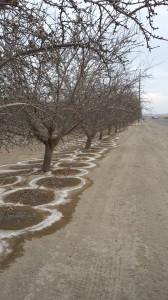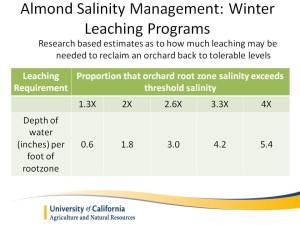
AUTHORS NOTE: The following article discusses salinity management considerations for FINE TEXTURED SOILS (e.g. loams, silts, and clays). This is a follow-up to the previous article, “Salinity Management for Sandy Soils.” For the most part, this article describes issues with the WEST SIDE of the San Joaquin Valley. NOT ALL SOILS ARE THE SAME. Please note that the following guidelines may need site-specific adjustments.
Starting with the soil, we often use the term cation exchange capacity (CEC), which is the amount of cations (positively-charged ions like sodium, magnesium, calcium, potassium, etc.) that can bind to the soil particle surface. In fine textured soils across the State, CEC values can be very high, with values ranging between 15-40 meq/100 g of soil. Generally, sandy loams are in the teens through 20s, and silts and clays are in the 30s to 40s. This CEC value is important as it indicates the amount of cations the soil particles can hold. The higher the CEC, the more cations that stick to the soil, preventing them from entering the soil water (soil water is the amount of water that is held between soil particles – it is what the tree drinks), reducing salt exposure to the roots of the tree. Regardless of the CEC, once the soil is saturated with cations, the excess will stay within the soil water. As soil salinity increases, the tree’s roots salt exposure is increased. High soil salinity affects the osmotic movement of water, and this impacts the tree roots’ uptake of water (e.g. essentially making the tree work harder for water), leading to eventual toxicity.
Salt toxicities within fine textured soils can vary based on the element involved. Chloride toxicity can occur rapidly, showing up within a year or two when applying poor quality water. This is due to chloride being an anion, and due to its negative charge, is unable to stick to the soil particle. Boron is similar to chloride, existing as a weak anion (or neutral), but it takes about twice as much water to leach. In contrast, sodium is an anion and can take several years to accumulate before toxicities is observed. These elements are cations, and will stick to the soil particle until the cation exchange sites are saturated. This is why it takes longer to see salt burn even with higher salt-containing waters.
This high buffering capacity makes it difficult to manage salts in fine textured soils. Once salts build within the soil profile, it may take 2-3 years of a dormant leaching program in order to successfully manage salts. This also assumes that subsequent water years will make use of cleaner water (ECw <1.5 dS/m).
Before the leaching program can be determined, there are several analyses that need to be conducted. Soils should be sampled down to five feet. The water that is planned to be used for the leaching program should also be analyzed. It is important to realize that the soil salinity will never drop below the salt concentration of the water.
This article, for the most part, will focus on sodium as it is more difficult to leach than chloride. Chloride will leach rapidly due to its negative charge, and most chloride problems can be reduced with a modest winter leaching program.To leach boron, the same practices should be followed, but more water is needed.
If soil EC is greater than 1.5 dS/m as an average for the five sampling depths, a winter leaching program should be considered. It is important to begin this process early in the dormant period in order to complete it before root expansion (mid-January). Enough water must be applied to fill the soil profile. Once the profile is full, smaller quantities of water applied either through rain or irrigation more frequently is the best way to move salts below the root-zone. In developing a program, its best to refill the profile early with irrigation water as all subsequent rainfall will aid the leaching program. Be careful not to saturate the soil for prolonged periods as this may increase the risk of root diseases.

The amount of water needed to leach the salts below the rootzone is highlighted in table 1. This table can be used to calculate water needs to reach any target soil EC and the inches reported are inches per foot of rootzone. An example of use is as follows: If the current soil EC is 4.5 dS/m as an average of five feet of rooting depth, and our target EC is 1.25 dS/m, we divide 4.5 by 1.25 to determine the proportion of exceedance. In this case, the value is 3.6. Based on the table, an estimated 4.7″ of water per foot of rootzone would be needed to drop the soil EC to 1.25 dS/m. For a five feet rootzone, this is 23.5″ of water on top of what is needed to refill the soil profile. This assumes that the salt level of the water is <1.25 dS/m. If the water is cleaner, less water may be needed. Remember that chloride will leach rapidly due to its negative charge, and most chloride problems can be reduced with a modest winter leaching program. Furthermore, keep in mind that rainfall should be subtracted from this total.
It may not be feasible to try and reduce the soil salinity back within the target range within a single year. This is especially true if the leaching program has been neglected over the past few years. In these cases, try to reduce the salinity levels by half to help reduce the gradual build-up of salts.
There are other considerations when trying to apply leaching programs. Growers using single or double line drip may want to also consider to irrigate during rain events. Applications of water during this time will help “push” the salt out of the rootzone. It will also aid in filling the profile or leaching. This practice is a concern for drip irrigation systems since the volumes of wetted soil and root zone are diminished. Calcium-containing amendments should be utilized to help displace sodium from the soil CEC matrix. Depending on soil pH, this could either be gypsum or lime. If the water contains high amounts of calcium, it may also be suitable, but may require acidification in order to free up the calcium. If poor infiltration, run-off, or soil saturation occurs, irrigation run-times should be reduced. It may also be of use to utilize soil amendments to help with infiltration rates within the leaching program. These include calcium containing amendments, acidifying high pH water, and, if needed, soil surfactants. More on solving infiltration problems can be found here. Finally, remember to pull soil samples in the early spring to determine the effectiveness of the leaching program.


Soil Sampling for Salinity Challenges | AgNet West - California Agriculture News
February 15, 2016[…] From the Almond Doctor: Starting with the soil, we often use the term cation exchange capacity (CEC), which is the amount of cations (positively-charged ions like sodium, magnesium, calcium, potassium, etc.) that can bind to the soil particle surface. In fine textured soils across the State, CEC values can be very high, with values ranging between 15-40 meq/100 g of soil. Generally, sandy loams are in the teens through 20s, and silts and clays are in the 30s to 40s. This CEC value is important as it indicates the amount of cations the soil particles can hold. The higher the CEC, the more cations that stick to the soil, preventing them from entering the soil water (soil water is the amount of water that is held between soil particles – it is what the tree drinks), reducing salt exposure to the roots of the tree. Read more from The Almond Doctor blog. […]
Raquel
June 30, 2022David,
Thank you for the great information. What is the SAR threshold for Almonds before yields start to drop?
Davidd
August 1, 2022Raquel,
When the SAR is over 3, accumulation of sodium begins to occur within the soil. creating osmotic stress and tissue toxicity.
Hope that helps,
David